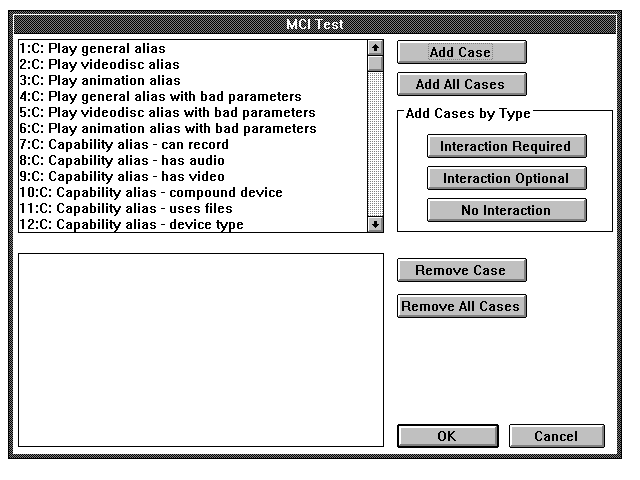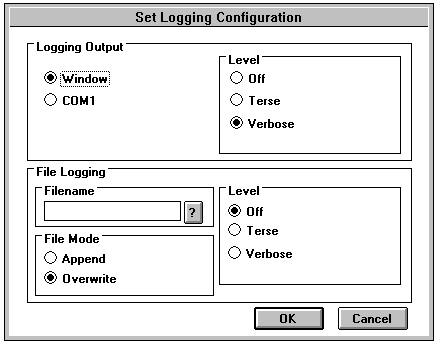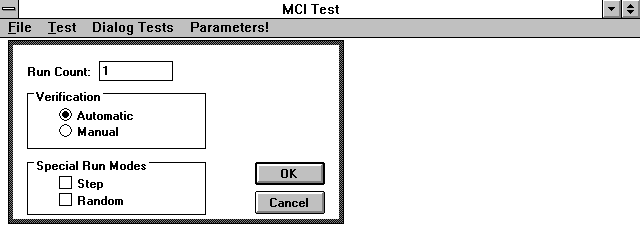
The Test menu contains commands that let you change the test profile, change the test environment, and run the tests. It contains the following commands:
| Command | Description |
| Set Input/Output Paths | Displays a dialog box to set the input and output paths. |
| Select Tests | Displays a dialog box to select test cases. |
| Run Tests | Runs selected test cases. |
| Set Logging | Displays a dialog box to set test logging. |
| Set Run Parms | Displays a dialog box to set test parameters. |
| Reset Logfile | Resets the test log file. |
| Reset Environment | Resets the test environment. |
Choose Set Input/Output Paths to specify the input and output paths for any data used during the test. Set Input/Output Paths displays the following dialog box:

Choose Select Tests to select the tests included in the test run. Select Tests displays the following dialog box:

The top list box displays the test cases available. The lower list box displays the selected test cases.
·To add and remove test cases from the lower list box:
 Double-click a test case in the upper list box to add it to the list of test cases.
Double-click a test case in the upper list box to add it to the list of test cases.
 Double-click a test case in the lower list box to remove it from the list of test cases.
Double-click a test case in the lower list box to remove it from the list of test cases.
 Select multiple tests using cursor-movement operations including SHIFT+click to select a range of cases or CTRL+click to select a disjointed set of cases. Choose Add Case or Remove Cases to change the status of the test cases.
Select multiple tests using cursor-movement operations including SHIFT+click to select a range of cases or CTRL+click to select a disjointed set of cases. Choose Add Case or Remove Cases to change the status of the test cases.
 Choose Add All Cases to add all test cases in the upper list box to the lower list box.
Choose Add All Cases to add all test cases in the upper list box to the lower list box.
 Choose Remove All Cases to remove all test cases in the lower list box.
Choose Remove All Cases to remove all test cases in the lower list box.
 Choose Interaction Required, Interaction Optional, or No Interaction to add test cases by level of user interaction.
Choose Interaction Required, Interaction Optional, or No Interaction to add test cases by level of user interaction.
 Choose Cancel to exit the dialog box and discard any changes made to the list of test cases.
Choose Cancel to exit the dialog box and discard any changes made to the list of test cases.
 Choose OK to exit the dialog box and save the selected test cases to execute.
Choose OK to exit the dialog box and save the selected test cases to execute.
·To execute the selected test cases you just saved:
 From the Test menu, choose Run Tests.
From the Test menu, choose Run Tests.
You can log test results to a specified file, and log to either COM1 or to a window. You cannot log to COM1 and a window at the same time. Choose Set Logging to display the following dialog box:

To log to COM1 or a window, select the destination using the Logging Output controls. Use the Level controls to specify the log messages you want to receive.
To log to a file, enter the name of the destination file in the Filename text box. Use the File Mode control buttons to specify whether the log messages are appended to or overwrite an existing log file. Use the Level controls to specify the log messages you want displayed.
You can clear the contents of the current log file at any time by choosing Reset Logfile on the Test menu.
Choose the Run Tests command to execute the selected tests. You can set the number of times a test sequence are executed by choosing Set Run Parms on the Test menu. Set Run Parms displays the following dialog box:

The Verification controls in this dialog box let you choose whether or not tests using a YES/NO box should be verified by the tester.
The Special Run Modes controls let you choose to run the tests randomly or step through the tests.